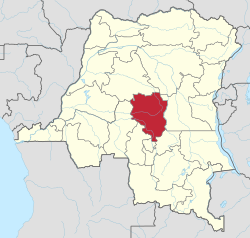
Summary
Sankuru is one of the 21 new provinces of the Democratic Republic of the Congo created in the 2015 repartitioning. Sankuru, Kasaï-Oriental, and Lomami provinces are the result of the dismemberment of the former Kasaï-Oriental province.[2] Sankuru was formed from the Sankuru District whose town of Lusambo was elevated to capital city of the new province.
Sankuru
Province du Sankuru (French) | |
|---|---|
 | |
 Flag | |
 | |
| Coordinates: 3°31′S 23°36′E / 3.517°S 23.600°E | |
| Country | |
| Created | 2015 |
| Named for | Sankuru River |
| Capital | Lusambo |
| Government | |
| • Governor | Jules Lodi Emongo[1] |
| Area | |
| • Total | 105,000 km2 (41,000 sq mi) |
| Population (2020 est.) | |
| • Total | 2,593,400 |
| • Density | 25/km2 (64/sq mi) |
| Time zone | UTC+2 (CAT) |
| License Plate Code | |
| Official language | French |
| National language | Tshiluba |
The 2020 population was estimated to be 2,593,400.[3]
Administration edit
The capital of the province is Lusambo.[4]
While Sankuru's territories are governed by Territorial Administrators and his Deputy, including various Counselors, cities in Sankuru are governed by Mayors. Townships or collectivities have always Mayors with Council and villages are mainly governed by traditional Kingdoms according to succession legacy. Administered from 1966 to 2009 as the District of Sankuru, the province is now divided into 6 territories:
- Katako Kombe – with the town of Katako-Kombe and the City of Lumumbaville
- Kole – with the town of Kole
- Lodja – with the City of Lodja
- Lomela – with the town of Lomela
- Lubefu – with the town of Tshumbe Ste Marie and the city of Lubefu
- Lusambo – with the City of Lusambo
History edit
Sankuru was administered as a province from 1962 to 1966. However, from 1966 to 2015, Sankuru was administered as a district as part of the Kasaï-Oriental province.
Land edit
The major geographical features are Sankuru River, Lomami River, Lubefu River and Lukenie River. There are typically three natural environments in the province: forest, savanna and bush. There are numerous mountains, valleys, and striking natural obstacles. This province has some of the richest Congolese fauna with its various species of animal including from lions, zebras, antelope, kudu, hippopotami, various species of tropical snakes, crocodiles, turtles, various species of monkeys, an array of fish species, various birds, and chimpanzees. Sankuru has very rich biodiversity.
Fauna edit
Flora edit
Tourism edit
Economy edit
Sankuru is mainly an agricultural and farming region. Staple crops are rice, banana, pineapple, potatoes, sugar cane, coffee, sorghum, casavas, corns and various local agricultural produce. Due to the lack of energy, Sankuru's industry is poorly developed and limited to traditional wood production, fishing and construction brick factories for local consumption and agricultural freights transportation. It's important to mention that Sankuru province has significant airlifting, waterways and routes transportation potentialities that need to be fully developed.
The lack of developed roads, electricity, clean water and viable transportation infrastructure is significantly challenging Sankuru's development. The economy is essentially focused on imported trading goods and freights moving due to the lack of developed roads, electricity, clean water and viable transportation infrastructure that significantly challenge local people.
Sankuru has rich mineral ground: diamond, gold, mercury, iron, cassiterite as well as various other mineral resources. To an important extent, the province depends on imports of primary supplies from large Congolese cities such as Kinshasa, Mbuji Mayi, Lubumbashi, Kindu and recently from Goma.
People edit
Former prime Minister Patrice Emery Lumumba and musicians such as Papa Wemba (Shungu Wembadio Pene Kekumba), Koffi Olomide, and Franco Luambo Makiadi (Lokanga La Ndju Pene) are from Sankuru Province. The first Congolese Army General, Victor Lundula, General Otshudi and General Francois Olenga are also all from Sankuru.
Education edit
Sankuru's primary and secondary schools are mainly organised by the Catholic, Protestant or Methodist and the Kimbanguist Churches. However, The Congolese Government also organises public schools via its Education Department. From around 2010, the province of Sankuru has recently welcomed many newly families and private individuals owned Elementary and High Schools.
Sankuru have several universities: Patrice Emery Lumumba University with a Campus in Lodja and Tshume-Ste-Marie, Saint Anne University with a campus in Tshumbe-Ste-Marie and Lusambo, several Colleges and University in Lumumbaville.
See also edit
References edit
- ^ "Sankuru : Parfaite communion entre le Gouverneur Jules Lodi et ses administrés". Alternance.cd (in French). 29 June 2022. Retrieved 1 July 2022.
- ^ "RDC : le Kasaï-Oriental éclate en trois nouvelles provinces". Radio Okapi (in French). 16 July 2015. Archived from the original on 18 July 2015. Retrieved 3 June 2020.
- ^ "Congo (Dem. Rep.): Provinces, Major Cities & Towns - Population Statistics, Maps, Charts, Weather and Web Information". www.citypopulation.de. Retrieved 2024-02-11.
- ^ "Provinces of the Democratic Republic of Congo". Statiods.com.


